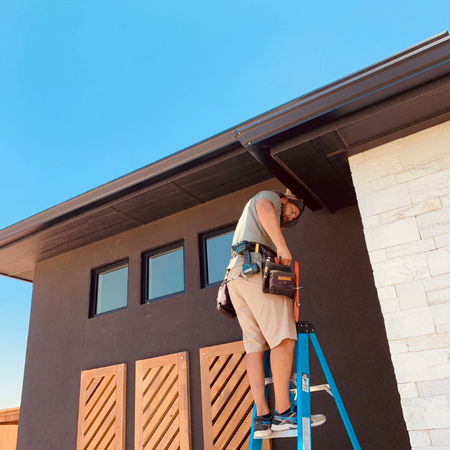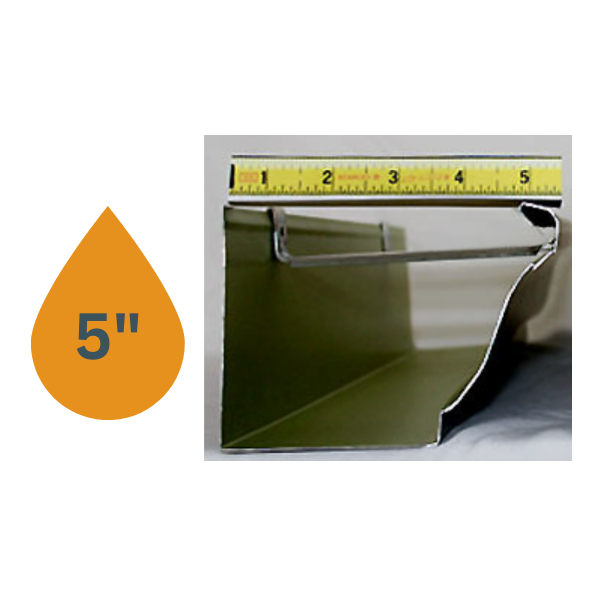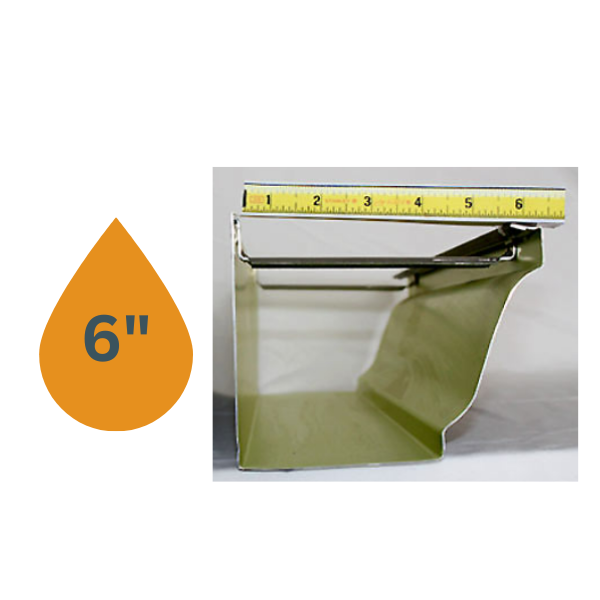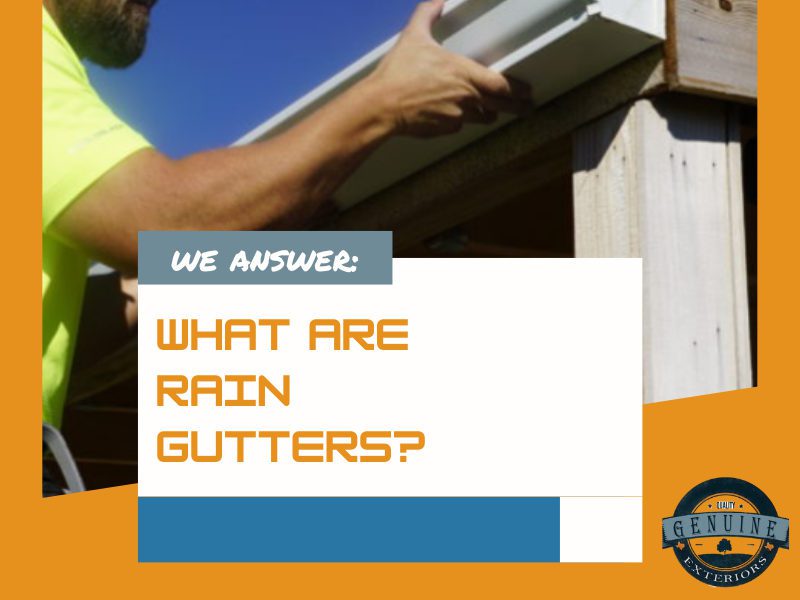What are rain gutters?
Sure, you might know the simple answer – they are those long channel-like troughs that collect water by your roof’s edge. But do you know how important they are in protecting your home?
Today, we will help you determine if your home needs rain gutters, what type of rain gutters you can choose from, and which materials are the most durable/cost-effective.
First, what are rain gutters?

When it rains, your home’s roof collects the brunt of the water. The water flows down your roof and is collected by your home’s gutters – a simple concept to understand.
As the roofing and gutter company Top Dog Home Pro put it, “Rain gutters are long, narrow, shallow troughs mounted on the edges of a home where the fascia boards meet the roof. Rain gutters are designed to collect the rainwater off the top of a home, then gather water and transport it down the downspouts into designated run-off areas.”
Typically, you won’t give your rain gutters much thought unless you notice an issue. Common gutter system issues include:
- Clogged gutters
- Broken or cracked gutters
- Missing gutters
- Leaking gutters (water flys over your gutters)
- Gutters sagging from your roof/the fascia board
If you experience any of these, you will need to take immediate action to replace or repair our gutter system. More on gutter installation and gutter cleaning later.
Are your gutters necessary?
Now that you know what gutters are – a glorified drainage system for your home’s roof – you might ask, “Why are gutters important, and are they necessary?”
Gutters are essential because they protect your home’s foundation and exterior in addition to adequately displacing runoff water from rain. Your home’s gutter system helps with the following:
- Protecting your home’s foundation and preventing basement flooding
- Catch rainwater and place it away from the home
- Prevent rain from rolling down your home’s exterior walls
- Properly installed gutters should protect your landscaping and prevent erosion.
- Prevents costly damage from water damage
- Protect siding, windows, and doors from leaks. Your home’s siding is porous.
However, just because gutters serve a vital function and most homeowners have them, that doesn’t always mean you need them. Depending on where you live or your home style, you might not need gutters.
When you don’t need gutters:
We once installed gutters on a home with a natural rain rock system around the house that was designed to let the water run off the roof and land on the rocks. The new homeowner wanted gutters because they were tired of the rain from heavy storms, but technically they did not need gutters.
Here are some other instances when you might not need gutters:
- Size of your overhang. If your roof overhang is only a few inches, you don’t have room for gutters.
- Natural water disposal method. A rock garden around the perimeter of your home, like the kind mentioned above, is a way to dispose of rainwater without it damaging your foundation.
- Sharply peaked roof. If you have a sharply peaked roof with an overhang of 12 inches, you can forgo gutters depending on your soil.
- Concrete around your home. You can sometimes avoid gutters if your home is surrounded by concrete, like patios or a driveway. However, we don’t recommend that. Rainwater can cause concrete erosion!
- Soil type. If you live in a very arid climate with little rain or you have super sandy soil (think Coastal Georgia, Florida), then your home might have been built without gutters.
Use our Gutter Calculator!
Easily estimate the cost of what new gutters will cost for your home!
Thanks, we will contact you soon, if you have questions please feel free to reach out.
Pick Your Gutter Color















Pick Your Gutter Color















Estimate Total Footage
Estimate the linear distance in feet for your gutters and also your downspouts!
- You can use Google Maps to search for your home and use the measuring tool to measure your home, or simply use rough estimates (if the front of your home is 40' across and there is one long gutter, you can estimate that at 40').
- Downspouts are usually 13 feet for a one-story home and 23 feet for a two-story home. Count the number of downspouts you have in your home currently.
Remember, this is just an estimate; the final total will be calculated when our install team measures for materials.
Estimate Total Footage
Estimate the linear distance in feet for your gutters and also your downspouts!
- You can use Google Maps to search for your home and use the measuring tool to measure your home, or simply use rough estimates (if the front of your home is 40' across and there is one long gutter, you can estimate that at 40').
- Downspouts are usually 13 feet for a one-story home and 23 feet for a two-story home. Count the number of downspouts you have in your home currently.
Remember, this is just an estimate; the final total will be calculated when our install team measures for materials.
Would you like to add gutter protection?
You can select from one of two options for gutter protection, affordable OR self-cleaning (no maintenance required).
Estimate the total amount of gutters (do not include the downspouts). Remember, this is just an estimate; the final total will be calculated when our install team measures materials.


Final Cost
The final estimated price is :
Summary
| Description | Information | Quantity | Price |
|---|---|---|---|
| Discount : | |||
| Total : | |||
Types & Materials of Rain Gutters:
Aluminum Gutters


Aluminum gutters are the most commonly found gutters in a home. They are .025 inch, and .027 inch in thickness and come in 5-inch and 6-inch sizes. The downspouts are either 2×3 inches or 3×4 inches. Chances are your home has aluminum gutters.
Pros:
- Cheap to install and have a custom fit with professional installation
- Wide variety of color selection
- The cost per linear foot is significantly less than any metal/copper gutters.
- K-style has a pleasant aesthetic appearance.
- Seamless gutters are durable and not known to leak
- Easy maintenance or installation of gutter guards
- Often you can replace it with a new roof
Cons:
- They can dent easily if hit with, say, a branch
- Need to be maintained from leaves and debris
- No DIY; they need to be professionally installed
Vinyl Gutters
Vinyl gutters are rarely used unless a homeowner decides to do a DIY project for their shed. Because vinyl gutters are brittle and break easily, they don’t do a great job of supporting your home’s rainwater. Vinyl gutters are also sectional, meaning they have joints that can be easy points of leakage.
Our recommendation – is don’t use vinyl gutters ever. While they are the cheapest, they will only last a few seasons. The only time it makes sense to use vinyl gutters if for guttering simple structures such as a shed or small porch. Remember, gutters protect your home’s siding.
Galvanized Steel Gutters
Galvanized steel gutters are undoubtedly lovely and sturdy but also costly. Similar to their counterpart – aluminum gutters – steel gutters can handle the rain and look great. The only difference is they are much more sturdy and often come in a half-round style. If you decide to use a stainless steel gutter, keep in mind you will want to have it professionally installed by a rain gutter contractor.
Copper Gutters

Perhaps the best-looking rain gutter system, copper gutters are certainly a nice addition to a victorian or farm-style home, but they also cost a pretty penny. The beauty is temporary once it gives way to the greenish patina, but some people prefer the look. However, as we mentioned, while durable and pretty, copper gutters are not friendly on the wallet.
Cast Iron Gutters
Unless you’re visiting a historical city or own a home that was built at the turn of the 20th century, chances are you have very rarely seen cast iron gutters. While they fall into the category of metal gutters, they’re not the standard gutter choice for most homeowners. However, for some elegant homes, some owners may prefer to pay for the extraordinarily hardy but super pricey cast iron rain gutters.
K-Style vs. Half-Round Gutters:

The most common gutters are aluminum k-style gutters, followed by half-round gutters. Both carry water exceptionally well and effectively.
K-style gutters are seamless aluminum gutters that are custom-cut on-site to fit your home’s exact dimensions. These gutters are known to be durable, and the “K-Style” look gives the curb appeal most homeowners desire. They come in 5 and 6-inch sizes, and they are hung with hidden hangers. The sites look like K, and the bottoms are flat.
Half-round gutters are like pipes cut in half and resemble a traditional trough. Generally, they are installed with brackets, and the downside to half-round gutters is that they let more debris in a while, also only coming in steel, copper, or metal. This makes them classier looking but more expensive for the everyday homeowner.
Frequently Asked Gutter Questions:

How long do gutters last on a house?
Depending on the type of rain gutters you have on your home and the care you provide them with, your gutters can last between 20-50 years. Variables that will negatively or positively impact the lifespan of gutters include:
- Regular cleaning (or not)
- Gutter guards for your rain gutters (or none)
- Type of gutters
- The geographical location (wind, branches, etc, can damage gutters in a bad storm)
How much do new gutters cost?
New gutter prices vary depending on the material and are priced per linear foot. On average, aluminum rain gutters can range from $6 to $12 per linear foot and the metal gutter varieties/copper gutters can approach $20 per linear foot.
A standard homeowner replacing 250 linear feet of aluminum gutters and downspouts can expect to pay around $1800 to $2800, depending on where you are located, the color of aluminum you choose, and the contractor.
➡️You can use our FREE gutter calculator here to estimate your costs!
What gutters are the most popular?
Seamless aluminum gutter systems are the most popular gutters. They are known for their affordability and durability. When selecting a gutter system, recognize the primary purpose of what your rain gutters do and how their performance is integral to your home’s foundation.
Can I install gutters myself or DIY gutters?
You can install anything yourself, but rain gutters are not something we recommend doing yourself. There is plenty of reasons to hire a gutter company to replace your gutter system, but the most significant three are:
- Knowledge of pitch, proper installation, and customization of gutters
- Most homeowners will purchase cheap vinyl gutters that will often leak
- Ladder safety – it is not worth getting on a ladder if you are inexperienced
Should I install gutter guards?
Gutter guards are similar to gutter materials in that there is a wide variety to choose from. When selecting gutter guards, we recommend you choose a guard that is not a flat mount (these gather leaves) and one that is self-cleaning. Gutter guards are useless if you have to clean them 😉.
Gutter protection is recommended, but you can also clean your rain gutters every fall.
Can I replace my roof without replacing my gutter system?
Yup! If you have functional gutters, but you are purchasing a new roof, you don’t have to get new rain gutters. Some contractors may encourage you to consider upgrading your rain gutter system depending on age and the fascia boards’ condition.
Sometimes it might make sense to get new gutters with your new roof, but you don’t have to! If your contractor is replacing your roof, where the roof eaves gutters meet, they must know they are keeping them or discarding them!






 The 5 BEST Gutter Companies in Lubbock, Tx
The 5 BEST Gutter Companies in Lubbock, Tx